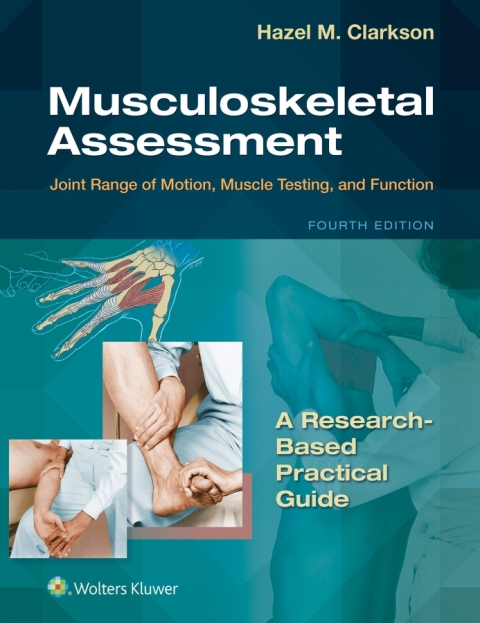Description
Efnisyfirlit
- Cover
- Half Title
- Title
- Copyright
- Dedication
- Reviewers
- Preface
- Acknowledgments
- Contents
- SECTION I: Principles and Methods
- Chapter 1: Principles and Methods
- Introduction to Principles and Methods
- Joint Range of Motion
- Assessment and Measurement of Joint Range of Motion
- Assessment and Measurement of Muscle Length
- Manual Assessment of Muscle Strength
- Practice Makes Perfect
- Functional Application of Assessment of Joint Range of Motion and Manual Muscle Testing
- Chapter 2: Relating Assessment to Treatment
- Chapter Rationale
- Similar Assessment and Treatment Methods
- Key Steps When Applying Assessments and Treatments
- Examples of Similar Assessment and Treatment Methods
- SECTION II: Regional Evaluation Techniques
- Chapter 3: Shoulder Complex
- Articulations and Movements
- Anatomical Landmarks
- Range of Motion Assessment and Measurement
- Muscle Length Assessment and Measurement
- Muscle Strength Assessment
- Functional Application
- Chapter 4: Elbow and Forearm
- Articulations and Movements
- Anatomical Landmarks
- Range of Motion Assessment and Measurement
- Muscle Length Assessment and Measurement
- Muscle Strength Assessment
- Functional Application
- Chapter 5: Wrist and Hand
- Articulations and Movements
- Anatomical Landmarks
- Range of Motion Assessment and Measurement
- Muscle Length Assessment and Measurement
- Muscle Strength Assessment
- Functional Application
- Chapter 6: Hip
- Articulations and Movements
- Anatomical Landmarks
- Range of Motion Assessment and Measurement
- Muscle Length Assessment and Measurement
- Muscle Strength Assessment
- Functional Application
- Chapter 7: Knee
- Articulations and Movements
- Anatomical Landmarks
- Range of Motion Assessment and Measurement
- Muscle Length Assessment and Measurement
- Muscle Strength Assessment
- Functional Application
- Chapter 8: Ankle and Foot
- Articulations and Movements
- Anatomical Landmarks
- Range of Motion Assessment and Measurement
- Muscle Length Assessment and Measurement
- Muscle Strength Assessment
- Functional Application
- Chapter 9: Head, Neck, and Trunk
- Articulations and Movements: Head and Neck
- Anatomical Landmarks: Head and Neck
- Instrumentation and Measurement Procedures: TMJ and Spine
- Active Range of Motion Assessment and Measurement: Head and Neck
- Validity and Reliability: Measurement of the TMJ and Cervical Spine AROM
- Muscle Strength Assessment: Muscles of the Face
- Muscle Strength Assessment: Muscles of the Head and Neck
- Articulations and Movements: Trunk
- Anatomical Landmarks: Trunk
- Active Range of Motion Assessment and Measurement: Trunk
- Validity and Reliability: Measurement of the Thoracic and Lumbar Spine AROM
- Muscle Length Assessment and Measurement: Trunk
- Muscle Strength Assessment: Muscles of the Trunk
- Functional Application: Neck and Trunk
- SECTION III: Appendices
- Appendix A: Sample Numerical Recording Form: Range of Motion Assessment and Measurement
- Appendix B: Sample Recording Form: Manual Muscle Strength Assessment
- Appendix C: Summary of Patient Positioning for the Assessment and Measurement of Joint Motion, Muscle Length, and Muscle Strength
- Appendix D: Gait
- Appendix E: Practice Makes Perfect–Summary & Evaluation Forms
- Index





